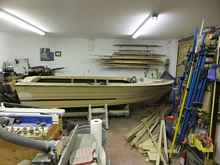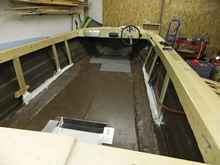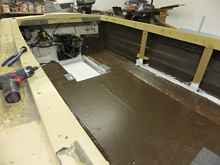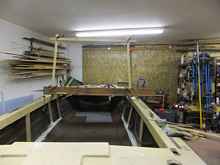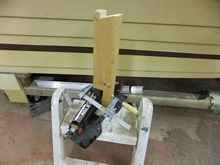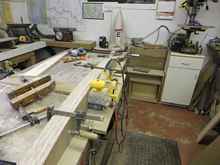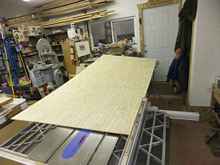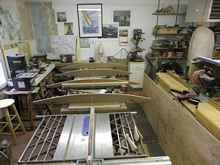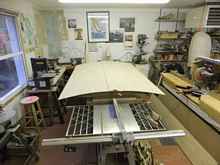Part One - Part Two - Part Three - Part Four
The light at the end of the tunnel is not only a train. But, that train has turned around!
I weighed the simplicity of putting this boat back together more or less like the original. Then, with some prodding from here and there, I concluded that something with a pilot house and Bruce anchor up forward, towing bits back by the engine box, and a diesel fireplace would probably get more use. So, Roughneck is going through the birthing process. Sort of like some of the rest of us, this one wasn’t planned. I guess there’s 3 or 4 man-days into the project so far (tear out/replacement). She’ll get about 6 weeks of the Building Season, hopefully be ready to go back on a trailer, and then make room for some of her sisters in the shop. There’s only so much winter to go around.
Just about everything that doesn’t add to the workboat format has been removed. Over the next couple weeks, things will begin to sprout above that conveniently-flat sheer line.
Wires, cables, hoses, a 20 gallon gas tank, and several seasons’ worth of wasp nests are now gone from under the foredeck. I’m still trying to decide if the steering wheel and gage panel will stay put for the first sea trials. There will be a round house/trunk cabin just forward of the old windshield line that will add vertical space over the foot of a berth and access to the forward hatch and anchor windlass. All, just in my head, at the moment.
That quarter by 3” steel angle will stiffen the forward motor mount’s underpinnings -I hope.
The floor is replaced, and the motor well-bilge pan is just about ready to receive that really-heavy Chevy Six. But, I’ll probably wait until all that climbing around during the building phase is done.
After several hours of messing with different angles and heights for the coach roof, I simply decided to go build it, and hang it up over the boat until it “looks about right.” Too much science seems to be excessive on this job.
I bounced between several window sizes. I finally decided that 24” is a convenient number when you are building a 6 foot long pilothouse. This is the “planning board.”
This little invention is what it took to bring the side decks back up to more or less level while stiffening and propping them up. They will have to hold a heavy cabin top.
The set of 4 deck beams - with several more to make after I figure out what they’re supposed to look like. Cut out of ¾” MDO, and shaped with a saber saw and belt sander. I discovered - again - that the pine pattern that I carefully crafted with a thoroughly deliberated fair curve, is not only easy to shape, the router-laminate trimmer bit’s bushing eats it up quickly too. I later remembered that the last time I did something like this, I used Masonite for the pattern. So much for the best laid plans…
…All I want for Christmas is a panel saw…
My 7 foot out feed table just barely accommodated the clamped-down “strongback” to position the cabin beams.
I said that I needed help to hold the panels up while I squirted the goop. Kate said, “Get a stick.” Good idea.
Waiting for the PL to do its stuff. Shaping and varnishing come next. Then, I’ve got to figure a way to levitate it across the shop and up into the air to fit supports, shear panels, and all that stuff. This will yield about 30 sqft under a 6 foot head room. Should be big enough for the basics. And, there will still be an adequate cockpit surrounding that humongous in-line six banger. I have no idea where the fuel tank(s) are going to hide. That will take one or more in-the-water tests to figure out. The whole metacentric heights thing for this hull has been tossed out the window. My normal method of determining stuff like that is by a home brew calculus I call Intuitive Extrapolation. But, this same basic hull design used to also support a fibreglass cuddy cabin and hard awning over the helm station. My workboat cabin ought to be OK.
|





